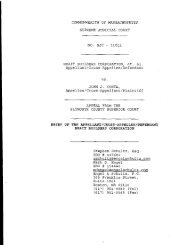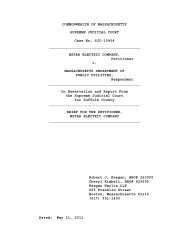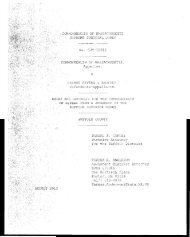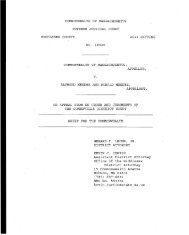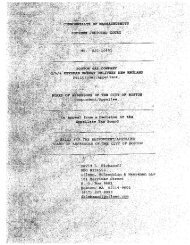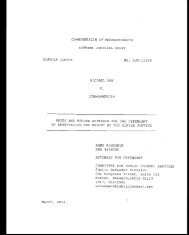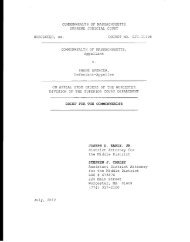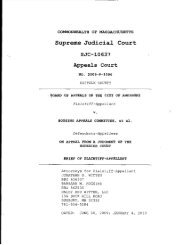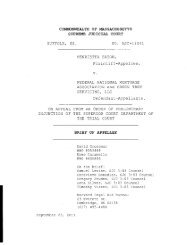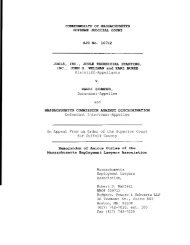464 Mass. 566 - Appellant Montoya Brief - Mass Cases
464 Mass. 566 - Appellant Montoya Brief - Mass Cases
464 Mass. 566 - Appellant Montoya Brief - Mass Cases
Create successful ePaper yourself
Turn your PDF publications into a flip-book with our unique Google optimized e-Paper software.
COMMONWEALTH OF MASSACHUSETTS<br />
Appellee<br />
Vs.<br />
EDWIN MONTOYA<br />
Defendant/<strong>Appellant</strong><br />
COMMONWEALTH OF MASSACHUSETTS<br />
SUPREME JUDICIAL COURT<br />
SJC-II086<br />
MIDDLESEX, SS.<br />
BRIEF AND RECORD APPENDIX OF THE DEFENDANT/APPELLANT<br />
ON APPEAL FROM A JUDGMENT OF CONVICTION AND<br />
DENIAL OF A MOTION FOR A NEW TRIAL ENTERED IN<br />
MIDDLESEX SUPERIOR COURT<br />
ATTORNEY FOR THE DEFENDANT/APPELLANT:<br />
PAUL C. BRENNAN, ESQ.<br />
BBO#055930<br />
623 MAIN STREET<br />
WOBURN, MA. 01801<br />
Tel.: (781) 935-6107<br />
Email: paulcbrennan@gmail.com<br />
Date: November, 2011
TABLE OF AUTHORITIES<br />
QUESTIONS PRESENTED<br />
STATEMENT OF THE CASE<br />
FACTS<br />
I. MOTION TO SUPPRESS<br />
TABLE OF CONTENTS<br />
II. THE TRIAL<br />
A. The Commonwealth's Case At Trial<br />
B. The Defendant's Case At Trial<br />
SUMMARY OF ARGUMENT<br />
ARGUMENT<br />
I. THE DEFENDANT'S MOTION TO SUPPRESS<br />
SHOULD HAVE BEEN ALLOWED BECAUSE AT<br />
THE PRECISE MOMENT THAT THE POLICE<br />
ARRESTED THE DEFENDANT THEY DID NOT<br />
HAVE PROBABLE CAUSE TO DO SO OR IN<br />
THE ALTERNATIVE THE STATEMENTS THAT<br />
THE DEFENDANT MADE DISCLOSING THE<br />
EXISTENCE OF THE HIDE WAS NOT SHOWN<br />
BEYOND A REASONABLE DOUBT TO HAVE<br />
BEEN MADE VOLUNTARILY<br />
A.The Pol Did Not Have Probab Cause<br />
To Arrest The Defendant<br />
B.The Defendant's Statement Disclosing<br />
The Existence Of The Hide Was Not Shown Beyond<br />
A Reasonable Doubt To Have Been Voluntarily Made<br />
Page No.<br />
iii<br />
1<br />
4<br />
9<br />
9<br />
14<br />
14<br />
18<br />
20<br />
22<br />
22<br />
22<br />
29
Page No.<br />
II. THE DEFENDANT WAS DEPRIVED OF HIS<br />
CONFRONTATION RIGHTS AT TRIAL WHEN<br />
DRUG ANALYSIS CERTIFICATES WERE<br />
ADMITTED INTO EVIDENCE AND WHICH ERROR<br />
WAS NOT HARMLESS BEYOND A REASONABLE<br />
DOUBT AS PERTAINING TO THE ISSUES OF THE<br />
NATURE AND THE WEIGHT OF THE ALLEGED<br />
CONTRABAND AND WHEREFORE HIS MOTION FOR A<br />
NEW TRIAL SHOULD HAVE BEEN ALLOWED 31<br />
A. The Evidence Concerning The Weight 34<br />
B. The Nature Of The Substance 40<br />
II. THE DEFENDANT WAS DEPRIVED OF THE<br />
EFFECTIVE ASSITANCE OF COUNSEL AT TRIAL<br />
AND WHICH CREATED A SUBSTANTIAL RISK OF<br />
A MISCARRIAGE OF JUSTICE 46<br />
CONCLUSION 50<br />
CERTIFICATION OF COMPLIANCE OF BRIEF<br />
ADDENDUM<br />
INDEX TO RECORD APPENDIX<br />
Ii
UNITED STATES CONSTITUTION<br />
TABLE OF AUTHORITIES<br />
Page No.<br />
Fourth Amendment 28<br />
Fifth Amendment 29<br />
Sixth Amendment 32, 48<br />
MASSACHUSETTS DECLARATION OF RIGHTS<br />
Art. 12 29, 48<br />
Art. 14 28<br />
MASSACHUSETTS STATUTES<br />
il<br />
IG. L. c. 94C, §32A(c) .' 4<br />
G.L. c. 94C, §32E (b) (2) 4<br />
G.L. c. 94C, §32J 4, 5<br />
G.L. c. 94C, §40 5<br />
G.L. c. Ill, §13 31<br />
UNITED STATES SUPREME COURT CASES<br />
Aguilar v. Texas,<br />
378 U.S. 108 (1964) 27<br />
Bollenbach v. United States,<br />
326 U.S. 607 (1946) 42<br />
Milton v. Wainwright,<br />
407 U.S. 371 (1972) 33<br />
Spinelli v. United States,<br />
303 U.S. 410 (1969) 27<br />
Weiler v. United States,<br />
323 U.S. 606 (1945) 41<br />
iii
Commonwealth v. Levy,<br />
459 <strong>Mass</strong>. 1010, 1011 (2011)<br />
Commonwealth v. Marini,<br />
375 <strong>Mass</strong>. 510 (1978)<br />
Commonwealth v. McCarthy,<br />
385 <strong>Mass</strong>. 160 (1982)<br />
Commonwealth v. Medeiros,<br />
395 <strong>Mass</strong>. 336, 343 (1985)<br />
Commonwealth v. Melendez,<br />
407 <strong>Mass</strong>. 53 (1990)<br />
Commonwealth v. Melendez z,<br />
76 <strong>Mass</strong>. App. Ct. 229 (2010)<br />
i'<br />
iCommonwealth v. Montanez,<br />
410 <strong>Mass</strong>. 290 {1991}<br />
Commonwealth v. Muniz,<br />
456 <strong>Mass</strong>. 166 (2010)<br />
Commonwealth v. O'Dell,<br />
392 <strong>Mass</strong>. 445 (1984)<br />
Commonwealth v. Perruzi,<br />
15 Mas. App. Ct. 439 (1983)<br />
Commonwealth v. Ramos<br />
<strong>Mass</strong>. App. Ct. (2008)<br />
Commonwealth v. Randolph,<br />
438 <strong>Mass</strong>. 290(2002)<br />
Commonwealth v. Rivas,<br />
77 <strong>Mass</strong>. App. Ct. 210 (2010)<br />
Commonwealth v. Rivera,<br />
76 <strong>Mass</strong>. App. Ct. 67 (2009)<br />
Commonwealth v. Rodriguez,<br />
75 <strong>Mass</strong>. App. Ct. 235, 242 (2009)<br />
v<br />
Page No.<br />
26<br />
33<br />
5<br />
29<br />
27<br />
44<br />
27<br />
33<br />
5<br />
42<br />
42<br />
48<br />
45<br />
39<br />
39
ecause (1) the evidence of kaging and conceal<br />
the ckets of alleged cocaine in hide the<br />
fendant's motor vehicle was suggestive of drug<br />
-dealing; (2) the jury was informed what an eight.<br />
was and therefore they could extr ate that to the<br />
twenty packets that they took into the evidence room,<br />
even though there was no evidence what any of Se<br />
ckets weighed and the jury returned several<br />
questions which clearly showed that they had great<br />
difficulty in determining what the total weight of the<br />
packets was and (3) the defendant allegedly made<br />
confession to the police that he had been engaged<br />
drug dealing but where the defendant took the stand at<br />
trial and denied having made this con ssion and<br />
therefore a credibility issue arose could only be<br />
resolved by a jury and the fendant's alleged<br />
confession could therefore have no relevance to a<br />
harmless error analysis in this case.<br />
Whether the defendant was deprived of the<br />
effective assistance of counsel which created a<br />
substant I risk of a misca age of justice where<br />
twenty packets alleged cocaine had been placed a<br />
at sealed bag that was marked as an exhibit and sent<br />
3<br />
1
into the jury room but on this bag was a tag or<br />
strip of unknown origin and which cated that the<br />
packets of leged cocaine weighed more than what was<br />
stated on t drug analysis certifi and the jury<br />
subsequently returned a question asking Court to<br />
instruct them as whether they were to this<br />
strip or the analysis certificate as weight<br />
of the twenty s and trial counsel did not object<br />
when the trial j instructed the jury that they<br />
could in effect either as the correct wei<br />
the alleged cocaine.<br />
STATEMENT OF THE CASE<br />
Pursuant to Bills of Indictment returned by<br />
Grand Jury for Mi'ddlesex County, the defendant was<br />
arraigned on December 21, 2006, Middlesex Superior,<br />
Docket No. MICR2006-01449, and under Count One<br />
with Trafficking In Cocaine r Twenty-Eight Grams<br />
And Less Than One Hundred Grams contrary to G.L. c.<br />
94C, §32E(b) (2); under Count Two h Distribution Or<br />
Possession With Intent To Distribute A Class B<br />
Substance, Specifically Cocaine contrary to G. L. c.<br />
94C, §3 (c); under Count Three with Vio ion Of The<br />
4
Drug Within A School Zone contrary to G.L. c.<br />
94C, §32J; under Count Four with Conspiracy To Violate<br />
The Drug contrary to G.L. c. 94C, §40. Record<br />
Appendix At Eight To Eleven. 1<br />
On July 6, 2007, the defendant filed a motion to<br />
suppress with a supporting memorandum of law and<br />
affidavit, RA 11-20, so two separate motions to<br />
dismiss. The motion to ss was based upon lack<br />
of probable cause for ndant's arrest and the<br />
\1<br />
{' involuntary nature of certain statements that the f<br />
defendant made at the Police Barracks. O:[1e· of<br />
the motions to dismiss was an ck on the integrity<br />
of the grand jury based upon v. 0' Dell<br />
392 <strong>Mass</strong>. 445 (1984). The other to dismiss was<br />
based upon the insufficiency of t e before<br />
the grand jury. See<br />
<strong>Mass</strong>. 160 (1982). An evidentiary ri was held on<br />
the motion to suppress on December '10 11, 2007,<br />
1 References to the Record Appendix are r<br />
abbreviated. For example, a reference to Page Nine Of<br />
The Record Appendix will appear as RA 9.<br />
5<br />
385
April 6, 2011, the defendant filed a timely notice of<br />
appeal from the denial of the motion for a new trial.<br />
RA 156. On April 14, 2011, the Appeals Court vacated<br />
the stay of the appellate proceedings.<br />
STATEMENT OF FACTS<br />
I. THE MOTION TO SUPRESS<br />
On August 8, 2006, at approximat y 1:00 p.m.,<br />
State Troopers Porter and Saunders, both in plain<br />
clothes, were in separate unmar d vehicles<br />
performing a roving surveillance of the parking I<br />
of the Stop & Shop Supermarket that was situated on<br />
the Everett and Chelsea city line. MTS1/6-7. This<br />
area was known to have a high incidence of narcotics<br />
activity. MTS1/8.<br />
While driving around in the parking lot, Trooper<br />
Porter observed two motor vehicles, one a white<br />
pick-up truck and the other a brown Toyota Corolla,<br />
parked adjacent to another two to three feet apart,<br />
but facing' in opposite directions. The driver's<br />
side of each these vehicles were in close<br />
proximity to each other, allowing the drivers the<br />
respective vehicles to converse with one another.<br />
9
They also appeared to be hanging out of windows<br />
of their respe ive vehicles. MTS1/10. As he drove<br />
past, Trooper Porter lost sight of these vehicles,<br />
so he turned around and then ked his vehi e<br />
about fty feet away. Trooper Porter then informed<br />
Trooper Saunders by radio about his obse ions.<br />
Trooper Saunders, who was nearby, turned around and<br />
passing these two vehicle, he observed from about<br />
forty feet away the driver of the brown Toyota pass<br />
something to the driver of the pick-up truck.<br />
However, he did not observe anything being<br />
back in exchange. MTS1/43-44,65. Trooper Saunders<br />
radioed Trooper Porter and informed him about what<br />
he had just seen and then drove to back of the<br />
parking lot and eventually followed the brown Toyota<br />
onto Route 16. MTS1/45. Meanwhile, Trooper Porter<br />
got out of his motor vehicle and approached the<br />
white pick-up truck. The brown Toyota had departed<br />
by then. The iver's side window of pick-up<br />
truck was still open and through it, oper Porter<br />
observed the driver of the pick-up truck ating a<br />
substance in a spoon then smoking through a<br />
glass tube. MTSl 12-13. After identifying himself<br />
as a police officer, Trooper Porter asked the driver<br />
10
anot r radio transmission from Trooper Porter<br />
informing him that he ( Porter) had talked to<br />
the driver of the pick-up t and that he been<br />
him smoking. MTS1/46,48-50. Trooper Saunders then<br />
got out of his vehicle approached the brown<br />
Toyota. The defendant, who was the driver of the<br />
brown T a, asked the what was going on.<br />
Trooper Saunders asked the if he had just<br />
bought drugs in the parking and then orde him<br />
out of the motor vehicle. er the defendant<br />
stepped out his car, Trooper Saunders pat fris<br />
the defendant and retrieved his wallet, his I.D. and<br />
a wad of cash in the amount of Thirteen Hundred<br />
00/100 ($1,300) Dollars approx 1 Y . MT S 1 / 4 9 , 5 0<br />
51. After Trooper Saunders then advised the<br />
,<br />
defendant of his Miranda rights, placed him under<br />
arrest and put him in his vehicle. Trooper Saunders<br />
drove the de ndant to the Medfo State Police<br />
Barracks. The brown Toyota was so towed to the<br />
barracks. MTS1 52-53.<br />
At the barrae , the defendant was first placed<br />
a holding cell. MTS1/77-78. Before the defendant<br />
was booked, Trooper Saunders told the fendant that<br />
12
directions, a t door opened underneath the<br />
passenger seat. From inside the hide, Lieutenant<br />
Brooks retrieved glyc e bags containing what<br />
appear to be an ounce-and-half or 28 grams of<br />
cocaine. Also found in the hide were some cell<br />
phones. MTS2 14-15. Lieutenant Brooks then went<br />
back to the booking area and where defendant<br />
still had one hand cuffed to wall. MTS2/15-16.<br />
The defendant was then unhandcuffed and brought to a<br />
small i erview room where enant ks advi<br />
the defendant of his Miranda rights a in an.9<br />
of red the defendant to have his statement audio<br />
recorded but he declined. Lieutenant Brooks then<br />
asked the defendant about the cocaine that was found<br />
in his vehicle. MTS2 17-18. The defendant then gave<br />
a lengthy statement about how he became involved in<br />
selling cocaine. MTS2 18-20. defendant did not<br />
call any witnesses.<br />
'II. THE TRIAL<br />
A. The Commonwealth's Case At Tri<br />
At trial, Troopers rter and Saunders testified<br />
concerning the stop of t defen nt and which<br />
14
Corcoran was prob ly originally an eight ball.<br />
(2/137) .<br />
er Messina, a eld engineer the City<br />
of Everett, testified that based upon the city<br />
assessor's map, it was his opinion that the distance<br />
between the Chelsea High School and the parking lot of<br />
the Stop and Shop Supermar t was two hundred and<br />
twenty and that the distance from high school<br />
all the way to the left side the very end of<br />
the rking lot was ill wi n one thousand feet.<br />
(2/140-144) .<br />
B. The Defendant's Case At Trial<br />
The grist the defendant's testimony was that<br />
about one week pri?r to his arrest, the defendant met<br />
an individual he only knew as Andres at a y.<br />
Andres showed him the brown Toyota and how to operate<br />
the electr c hide inside. The fendant thought<br />
that t hide was used to store important papers and<br />
money. (2/165-167). On day that he was arre<br />
he ran into Andres he 0 red to loan s brown<br />
Toyota the defendant. Later on, Andres cal the<br />
defendant and as d him to go to the parking lot of<br />
the Stop and Shop Everett and pick up some money<br />
18
The defendant then called Geir Boger, s<br />
oyer, as a character witness. Mr. Boger testi<br />
was the proprietor of a const business<br />
the defendant had worked for for six years<br />
and t the defendant had an Ie work ethic<br />
a reputation veracity and hfulness in<br />
workplace.<br />
SUMMARY OF ARGUMENT<br />
The evidence at the motion to suppress and<br />
findings made by motion judge show that at t<br />
t that the defendant was arrested by Trooper<br />
Saunders, the sum tot of the col i ve facts known<br />
to police officer may have been cient grounds<br />
for reasonable s icion but not probable cause to<br />
arrest him for distribution of cocaine. Pp. 22-28<br />
The statements that the defendant made disclos<br />
existence of hide were not vOluntarily<br />
e he had been kept in custody handcuffed to<br />
a 1, told that was in serious trouble and<br />
should tal k to the police and reasonably fe<br />
his car would damaged by a lice search for<br />
20
indicates t t person would not be free to leave<br />
without re to officer's inquiry is fun 1<br />
to seizure). The second and most crucial s on<br />
then is whether Trooper Saunders had probable cause to<br />
arrest the fendant at the moment that he ef<br />
the stop. Unfortunately, this issue is muddied by the<br />
somewhat ue testimony of Troopers Porter<br />
Saunders respectively concerning the radio<br />
transmissions that Trooper Saunders received<br />
Trooper Porter while he was following the de<br />
and which accounts do not ent ly mesh.<br />
Trooper Porter testified to sending just one<br />
radio transmission at this t , i. e. that the<br />
of the brown Toyota had just sold cocaine to<br />
driver of white pick-up. Trooper Saunders on<br />
other hand stified that the rst radio transmission<br />
that he re ved from Trooper Porter indicated<br />
Trooper Porter had found "product" but wit t<br />
providing details. MTSI 45-48. Trooper S rs<br />
testified that the second transmission that he<br />
received from Trooper Porter indicated that he<br />
(Trooper Porter) had observed the occupant of<br />
white pick-up truck as smoking something. MTSl 45-48.<br />
24
However, this radio transmission had occurred after<br />
Trooper Saunders had already st d the defendant.<br />
MTS1/45-49. Moreover, Trooper Sau rs did not<br />
testi that he ard Trooper Porter say that the<br />
defendant had just sold some coca to the occupant<br />
the white pick-up. In s findings of fact, the<br />
motion judge found only that Trooper Saunders had<br />
received first radio transmission. He made no<br />
finding concerning the second radio transmission. RA<br />
Accordingly, the sum total of the combi<br />
observations of both of these lice officers up to<br />
the moment t the de ndant was st d, consisted<br />
of the drivers of the brown Toyota and the pick-up<br />
truck conversing with one another in a parking lot,<br />
driver of the brown Toyota handing some unknown<br />
obje to the dr of the ck-up truck, the brown<br />
Toyota departing the scene and t the driver of the<br />
6At the motion hearing, the judge found the testimony<br />
of Trooper Saunders at first to be vague and confusing<br />
as to when he rece d the two radio tran ssions<br />
from Trooper Porter. However, the judge intervened and<br />
was careful to pin down Trooper Saunders as to when he<br />
received the rst radio transmission from Trooper<br />
Porter and when received second. The second<br />
radio transmission from Trooper Porter was received<br />
after he already stopped the fendant. MTS1/48<br />
49.<br />
25
the motion to suppress that Corcoran was a reliable<br />
informant. Probable cause to arrest a suspect sed on<br />
rmation provided by an informant must meet the<br />
familiar two part test rived Spinelli v. United<br />
States, 303 U.S. 410 (1969) and Aguilar v. Texas, 378<br />
U.S. 108 (19640. See Commonwealth v. Upton, 394 <strong>Mass</strong>.<br />
363, 369 (1985). The formant must have a basis of<br />
knowledge for the information provided, Spinelli, 303<br />
U.S. at p. 410, and the informant must also be<br />
reliable, Aguilar, 378 U.S. at p. 108. The defendant<br />
concedes that the basis of knowledge prong<br />
satisfied in this case. See Commonwealth v. Montanez,<br />
410 <strong>Mass</strong>. 290, 299-300 (1991). However, the veracity<br />
prong has not been satisfi When the Commonwealth<br />
relies on a statement inst an informant's penal<br />
interest to prove that the in rmation is reliable,<br />
the Commonwealth must show that the police knew the<br />
informant's identity. Commonwealth v. Allen, 4a6<br />
<strong>Mass</strong>. 575, 579 (1990), and the informant a<br />
reasonable fear of prosecution. Commonwealth v.<br />
Melendez, 407 <strong>Mass</strong>. 53, 57 (1990). In this case,<br />
although the occupant of the pick-up truck was<br />
identified as Corcoran, there was no evidence at the<br />
hearing of the motion to suppress that Trooper Porter<br />
27
was aware of his name and address the time that he<br />
questioned him. Furthermore, when Corcoran affirmed<br />
to Trooper er that had bought the cocaine from<br />
the defendant, this did not really constitute a<br />
statement inst 1 interest. After I, Trooper<br />
Porter had already ordered Corcoran out of his pick-up<br />
'truck and confiscated the alleged cocaine from him.<br />
Clearly, Corcoran was under arrest at t s stage<br />
he had nothing to lose by telling Trooper Porter what<br />
he wanted to hear, i.e. that the defendant was one<br />
sold him the cocaine.<br />
The fendant therefore respect lly submits<br />
fore that he was arrested without probable cause<br />
in violation of s constitutional rights under the<br />
Fourth Amendment to the United States Constitution and<br />
under art. 14 of the <strong>Mass</strong>achus ts Declaration Of<br />
Rights and the fruits of that unlawful arrest,<br />
cluding any statements that he made the police<br />
station and the subsequent search of his motor<br />
vehicle, are the fruits of a poisonous tree and must<br />
therefore be suppressed. See Wong Sun v. United<br />
States, 371 U.S. 471, 488 (1963).<br />
28
variable that differentiates the inquiries into the<br />
voluntariness of the waiver and the voluntariness of<br />
the statement is the interrogation techniques used by<br />
the investigating police officers. See Commonwealth v.<br />
Scoggins, 439 Mss. 571, 577 (2003).<br />
The defendant concedes that the evidence would<br />
support a finding that the defendant waived his<br />
Miranda rights. However, based upon the totality of<br />
the circumstances, the Commonwealth has not discharged<br />
the heavy burden that it has to show that the<br />
defendant's statements to Lieutenant Brooks concernirig<br />
the hide were voluntary. The undisputed evidence at<br />
the motion hearing was that Trooper Saunders pressured<br />
the defendant to co-operate with the police by telling<br />
the defendant that he was being charged with a serious<br />
crime and that it would be in his best interest to<br />
talk with him. The defendant continued to be held in<br />
the small booking room and handcuffed to the wall<br />
until Lieutenant Brooks arrived. To put further<br />
pressure on the defendant, Lieutenant Brooks told the<br />
defendant that a K-9 had alerted the police to the<br />
presence of narcotics in his motor vehicle. At first<br />
the defendant did not say anything in response to this<br />
30
the improperly admitted evidence 'might have had' on<br />
the fact finder or the findings." Vasquez, supra at<br />
3 62, quoting from Commonwealth v. Tyree, 455 <strong>Mass</strong>.<br />
-676, 704 n. 44 (2010). The requirement that the<br />
Commonwealth point to other overwhelming evidence to<br />
show that the error was harmless beyond a reasonable<br />
doubt is an extremely heavy one and not easily met.<br />
See Commonwealth v. Marini, 375 <strong>Mass</strong>. 510, 521 n. 12<br />
(1978), quoting Milton v. Wainwright, 407 U.S. 371,<br />
372-373 (1972) (noting that "overwhelming" evidence<br />
has en understood to mean evidence akin tothre<br />
full confessions).<br />
Furthermore, the Commonwealth does not establish<br />
that the error was harmless beyond a reasonable doubt<br />
simply by pointing'to other properly admitted evidence<br />
that would establish the legal sufficiency of the case<br />
against the defendant in absence the tainted<br />
evidence. Commonwealth v. Muniz, 456 <strong>Mass</strong>. 166, 169<br />
(2010). The error is not harmless beyond a reasonable<br />
doubt if " ...the Commonwealth's case 'radiates from a<br />
core of tainted evidence.' II Commonwealth v. Fluellen,<br />
456 <strong>Mass</strong>. 517, 526 (2010), quoting supra at<br />
702.<br />
33
A. The Evidence Concerning The Weight<br />
As part of its case against the defendant with<br />
respect to trafficking charge, Commonwealth<br />
introduced the drug certificate marked as Exhibit 7,<br />
which stated the coca weighed 39.74 grams or<br />
approximately twelve grams more than the threshold<br />
amount charged in the indictment. Moreover,<br />
eutenant Broo read this drug certifi into the<br />
record. (219-92) ; RA 53.<br />
,<br />
, " "<br />
In upholding the defendant's traff ickit{g<br />
conviction, the motion judge ruled t because<br />
jury was made aware through the testimony of ive<br />
Hyde that an "eight ball" was one eighth of an ounce<br />
or 3.5 grams and' \\ [f] rom this knowledge and ir<br />
general familiarity with weight, the jury d have<br />
ermined that the bags of cocaine in evidence<br />
weighed ater than twenty-eight " RA 155. In<br />
arriving at this conclusion, motion judge cited<br />
Commonwealth v. Connolly, 454 <strong>Mass</strong>. 808, 832 (2009).<br />
The Court's cision Connolly f supra, is<br />
inapposite here because facts in this case are<br />
34
easily distinguishable. In that case, a pol officer<br />
was allowed to testify at trial that one-eighth of an<br />
ounce of cocaine was the equival 3.5 grams and<br />
, that one-quarter ounce was seven The SJC held<br />
that this jury could extrapolate this that one<br />
hundred grams was less than ounces. Therefore<br />
when the large hard ball of coca was taken into the<br />
jury room, the jury could form a lay opinion that it<br />
weighed more than four ounces. Id. at pp. 831-832. In<br />
this case, there was no is r the jury to make a<br />
similar extrapolation. Although Detective Hyde, while;<br />
testifying how cocaine is ged for street sale,<br />
described an fteight " as one eighth of an ounce or<br />
3.5 grams, he did not testify that in his opinion the<br />
individually wrapped introduced into evidence as<br />
,<br />
Exhibit 5 were" ght balls flB • In fact, he admitted<br />
that he had not ewed any police reports nor had he<br />
even seen the s containing the alleged cocaine<br />
before taking (2/133-134): Furthermore, the<br />
motion judge's it finding that Detective Hyde's<br />
testimony provided reliable alternative evidence<br />
concerning weight of the alleged contraband<br />
8 Detective Hyde so stated that cocaine was samet s<br />
broken down into smaller lots for street s e in<br />
amounts one gram and half a gram. (2/128)<br />
35
harmless beyond a reasonable doubt where determining<br />
whether the aggregate wei of cocaine contained in a<br />
bag and several containers was over one hundred grams<br />
involved too much guesswork on too close a question<br />
the circumstances).<br />
B. The Nature Of Substance<br />
Paraphrasing in relevant rt t memorandum of<br />
decision on defendant's motion for a new trial,<br />
the motion judge ruled that independent circumstantial<br />
evidence
to support a conviction". Commonwealth v. Dawson, 399<br />
Ma s s. 465, 467 (1987) • Furthermore, the trial j<br />
did not make a finding that any of officers were<br />
qualified to testify as to the nature of the<br />
substances. See Vasquez, 456 <strong>Mass</strong>. at p. 365.<br />
Moreover, the officers " , not articulate how their<br />
rtise permitted them to identi the substances'."<br />
Commonwealth v. Charles, 456 <strong>Mass</strong>. 378, 382 (2010)<br />
quoting from Commonwealth v. Melendez-Diaz, 76 <strong>Mass</strong>.<br />
App. Ct. 229, 233 -(2010). No field tests were<br />
performed, none of the witnesses was involved<br />
gene ing the drug certi es, and tI [nJ one the<br />
officers observed the fects of the substances on<br />
anyone sting " Vasquez, supra at p. 364.<br />
The last two findings of the motion judge<br />
concerning packaging of the al ged contraband and<br />
the location of a sophisticat hide (which the on<br />
j found icularly important) are related as the<br />
implicit assumption underlying these two findings is<br />
that packaging of the alleged cont and and<br />
location of hide are evidence of a modus operandi<br />
of drug dealing cocaine as testified to by<br />
Detect i ve Hyde. The testimony of Detective Hyde<br />
44<br />
i
focused on cribing street level drug transactions,<br />
drug packing and the purposes of drug hi s. All<br />
circumstantial evidence of wrong doing to sure, but<br />
not compelling evidence concerning the nature of the<br />
substance as being cocaine. See Commonwealth v. Rivas,<br />
77 <strong>Mass</strong>. App. Ct. 210, 212 (2010) (foundation<br />
questions asked of police officer only entitled him to<br />
testify whether evidence of substance was consistent<br />
with distribution and not as to he nature of the<br />
substance) .<br />
In sum, there can be no dispute that the<br />
certificates were material and must have had a<br />
power impact on the jury with respect to the issues<br />
of the weight and the nature of the alleged<br />
contraband, especially as there was no attempt to<br />
dispute them. As has been already demonstrated, such<br />
independent circumstantial dence that was not<br />
tainted by the drug analysis certificates consisted<br />
exclusively of the mode of packaging of the alleged<br />
contraband in order to suggest drug aling. On the<br />
other hand, the Commonwealth placed great reliance on<br />
the drug analysis certificates at tria The drug<br />
analysis certificate pertaining to the alleged<br />
45
In his motion for a new t , the de also<br />
raised the issue of ineffect assistance of counsel.<br />
RA 59-60. As can be seen from affidavit sent<br />
'defense counsel submitted wi this motion, trial<br />
defense couns refused to provide any informat of<br />
his trial strategy in not obj ing to the admission<br />
of the drug ficates. RA 60-62.<br />
In view of the decision of the SJC in Vasquez<br />
decision rende after the ndant's motion r a<br />
new trial was led and the that the is<br />
entitled to harmless error analysis in this appeaT<br />
with respect to the drug analysis certificates, the<br />
issue of inef ive assistance of counsel in ling<br />
to object to r admission at trial is moot.<br />
However, re was one tant in the t where<br />
the conduct defense counsel was clearly cient<br />
and which is still before this Court. As scussed<br />
above at pp. 37-38 supra, there was no excuse for<br />
trial defense counsel in not obj ecting to t jury<br />
considering strip with t figure of 43.5 ams<br />
written on it and which strip was on t bag<br />
containing individual pa s of alleged cocaine<br />
in Exhib 5. This evidence was not only highly<br />
47
prejudi al but also inadmiss e hearsay. This was<br />
not a drug analysis certi cate and it did not corne<br />
within any known rule of evidence as an exception to<br />
the hearsay rule. Furthermore, the writing on s<br />
st was testimonial in nature and fore vi ated<br />
his confrontation rights under Sixth Amendment to<br />
the United States Constitution and art 12 of the<br />
<strong>Mass</strong>achusetts Declaration Of Rights. By failing to<br />
obj ect to this evidence, de e counsel failed to<br />
preserve this issue for appellate ew based upon<br />
t harmless error standard. Where ineffective<br />
assistance of counsel based upon waiver is al<br />
the standard of review is the substantial risk of a<br />
miscarriage of justice standard. See Commonwealth v.<br />
Randolph, 438 <strong>Mass</strong>. 290, 295-296 (2002). In the<br />
memorandum of law in support of his motion a new<br />
trial, the defendant raised this issue and also<br />
requested an evidentiary hearing. RA 82-84. The motion<br />
judge ruled that in light of the fact there was<br />
sufficient evi for the jury to termine the<br />
weight of the cocaine, t failure defense counsel<br />
. to object to the admission of the label on the bag did<br />
not constitute ineffective assistance of counsel. RA<br />
155.<br />
48
In applying less strict test of the creation<br />
a substantial sk of" miscarriage of justice, the<br />
st is whether erroneous adrniss of the label<br />
on the bag materially influenced verdict insofar<br />
as it hinged upon determination of the weight of<br />
alleged cont "The subst ial risk of a<br />
scarriage of justice standard has points of<br />
cornmonality with t more particulariz appellate<br />
standard of review governinq the legal fications<br />
a violation of constitutional confrontat rights .<br />
commonality between the standards involves<br />
late court's obI ion to assess materiality<br />
of e testimony that, in error, was not subject to<br />
confrontation by cross-examination, and to weigh the<br />
,<br />
effect of this erroneously admitted unconfronted<br />
imony against the st of the Cornmonwe th' s<br />
proof, notwithstanding the confrontation-related<br />
error." Commonwealth v. Brazie, 66 <strong>Mass</strong>. App. . 315,<br />
319 (2006).<br />
defendant respect ly submits that ew<br />
of fact that the jury clearly had great difficulty<br />
wi the question of the weight of the alleged<br />
cant and, one cannot s with fair assurance<br />
49<br />
. ...f"



